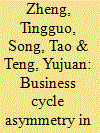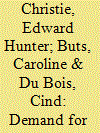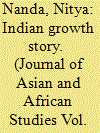| Srl | Item |
| 1 |
ID:
097832


|
|
|
|
|
| Publication |
2010.
|
| Summary/Abstract |
Friedman's plucking model of business fluctuations suggests that output cannot exceed an upper limit, but it is occasionally "plucked" downward below trends as a result of economic recessions. This paper investigates China's business fluctuations using quarterly real GDP data for the period 1978-2009. Our results show some evidence supporting Friedman's plucking model. We find that a ceiling effect of real output exists, and that negative asymmetric shocks significantly affect the transitory component, which captures the plucking downward behavior during the recession. The results also suggest that the basic asymmetric unobserved component model is not appropriate for directly modeling China's real output because the business cycle is inaccurately measured, but it works quite well when considering a structural break in the second quarter of 1992. The results reveal that although China's economy strengthened in the second quarter of 2009, it is essential for China's government to take further positive and effective measures to maintain sustainable development of the economy.
|
|
|
|
|
|
|
|
|
|
|
|
|
|
|
|
| 2 |
ID:
192039


|
|
|
|
|
| Summary/Abstract |
We explore the possibilities and limitations of models of the demand for military expenditures, as against additional kinds of cross-country analyses, with an empirical focus on the Indo-Pacific region. Our research bridges a gap between the Defence Economics and International Relations literatures by developing testable security alignment hypotheses and by testing these hypotheses in three ways: with demand modelling on total expenditures, with analyses on estimated stocks of imported armaments, and with qualitative analyses of trends in defence cooperation between states. We find consistent evidence across research methods of an increase in threat perceptions towards China since around 2012 and of balancing behaviour by US allies and by two non-allies. As compared to standard demand modelling, our hypothesis-based mixed methods approach allows for a clearer treatment of samples with mixed and shifting security alignments and of states that stabilise or reduce expenditures in the face of rising threat perceptions.
|
|
|
|
|
|
|
|
|
|
|
|
|
|
|
|
| 3 |
ID:
093699


|
|
|
|
|
| Publication |
2009.
|
| Summary/Abstract |
India embarked on a high growth path right in the early 1950s. However, due to some internal and external shocks, the economy slowed down from the mid-1960s until about 1980. Moreover, throughout the period, industry and services grew at higher rates compared to agriculture whose share in GDP was almost 60 per cent in 1950. Thus, the increasing trend in the overall growth rate is the reflection of the increasing shares of the high growing sectors in the GDP. It is also suggested that mere growth is not sufficient to reduce poverty, while poverty reduction may also impact growth positively.
|
|
|
|
|
|
|
|
|
|
|
|
|
|
|
|
| 4 |
ID:
110714


|
|
|
|
|
| Publication |
2011.
|
| Summary/Abstract |
In this paper, we re-examine the stochastic behaviour of per capita total primary energy consumption across 178 countries around the world. For this purpose, in addition to conventional unit root tests, we apply newly developed tests that allow for nonlinear adjustments and structural breaks in the data generating process. The results of the unit root tests show that allowing for structural breaks and nonlinearity result in more frequent rejection of the null hypothesis of unit root, suggesting that most of the series under consideration follow a stationary process. These findings imply that both energy economists and policy makers must be careful and take account of possible nonlinearities and structural breaks in their analyses of energy consumption. In addition, the results imply that government interventions into the energy markets in most countries have no effect in the long run, although the short-run effects of the interventions depend on the size and the direction of interventions.
|
|
|
|
|
|
|
|
|
|
|
|
|
|
|
|